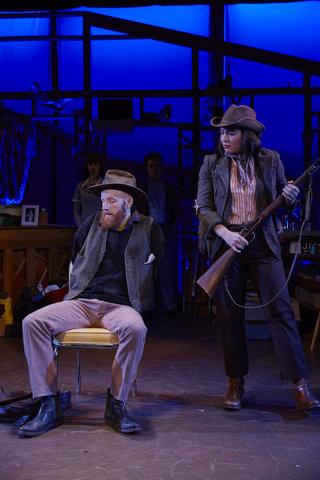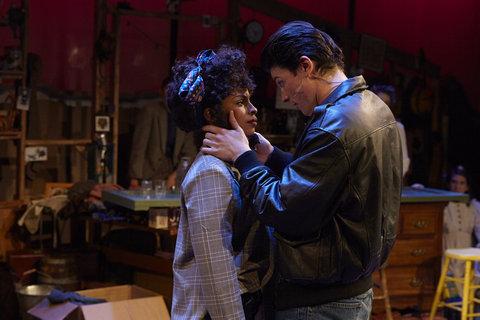Folk Wandering
Three stories rooted in Americana are alternately enacted in this charming and good-natured musical that’s beautifully performed by a terrific large cast.

Dan Tracy and Lena Hudson in a scene from Pipeline Theatre Company’s “Folk Wandering” (Photo credit: Suzi Sadler)
[avatar user=”Darryl Reilly” size=”96″ align=”left” ] Darryl Reilly, Critic[/avatar]Beautifully performed by a cast of eleven, Folk Wandering is a charming and good-natured musical rooted in Americana. The early 20th century immigrant experience, the mystique of James Dean and The Dustbowl of the 1930’s are alternately enacted. There is a female-centric concern to the material as well.
The show was conceived by Jaclyn Backhaus (Men in Boats) and Andrew Neisler, and Ms. Backhaus wrote the book. The three stories are imaginative takes on monumental historical episodes that are presented backward and forward with cast members often playing several roles.
The score is an accomplished blend of well-crafted songs in a variety of styles. Traditional show tunes, folk and 1950’s Rock and Roll are skillfully replicated. The lyrics and music are by Backhaus with additional lyrics by collaborating composers Blake Allen, Mike Brun, Andrew R. Butler, Joel Esher, Alex Fast, Jo Lampert, Barrie McLain, Annie Tippe, and Dominique Toney.
We are in the fabulous attic set of scenic designer Carolyn Mraz. Wooden beams adorn the back wall and there’s a rambling collection of weathered wooden chairs, stools and tables. Strewn around are trunks, luggage boxes, clothing and musical instruments hang of the walls. The cast enters and jovially addresses the audience. The show’s conceit emerges.
They’re friends in the present. Someone picks up yellowed newspaper articles from the past. Then we’re in New York City’s Lower East Side in 1911. We meet the spunky 13-year-old Roselia. She is the daughter of immigrants and her goal is to become a muckraking journalist. An exposé of the local butcher was one of her scoops that have been published. Her older sister is to marry a genial young man. Her parents are very affectionate but due to their hardscrabble circumstances it’s decided that after her impending 14th birthday, Roselia will leave school to join her mother and sister in working in a garment factory to bring in more money to the family.

Andrew R. Butler and Kim Blanck in a scene from Pipeline Theatre Company’s “Folk Wandering” (Photo credit: Suzi Sadler)
This heartbreaking thread is the most substantive, affective and dramatic of the three tales. The girlish and luminous Lena Hudson makes a great impact as Roselia. Kate Loprest’s practical but maternal characterization of the mother is perfect. “The House on Ludlow Street” is a haunting song that is woven through the narrative.
The handling of a black leather jacket transports us to September 30, 1955 to the Apache Tavern in rural Indiana. The garment belongs to Bobby, a handsome young man who has run off from the a touring rock band. Weariness and another broken romance have inspired him to lay low.
The townspeople believe that he is favorite son James Dean taking a break from Hollywood. There’s a lot of Grease-style theatrics, fun and a bittersweet tone. Adrian Blake Enscoe is dynamic as Bobby. Morgan Siobhan Green has an appealing intensity as Hannah, the band member who has pursued him. Physically imposing and with his booming voice, DeMone is hilarious as “Rat,” a bar denizen. DeMone is also wonderful as the Italian-accented father in the first story.
A vintage Dorothea Lange photograph of a bearded man takes us to Utah in 1933. A widow and her young daughter seek a better life in California and encounter a man who helps them. This is a wistful Depression-era saga. Kim Blanck conveys pioneer strength with her tender performance as Kal, the widow. Andrew R. Butler is soulful as Everett, the benefactor and Mr. Butler plays guitar throughout. Jordon Tyson is marvelously child-like as the daughter Alma.
The animated and highly talented ensemble includes Dan Tracy, Nicole Weiss and Seth Clayton. While wearing a top hat and twirling a cane, the tall, lean and beaming Mr. Clayton is terrific as a barkeep in a big musical sequence.

Morgan Siobhan Green and Adreian Blake Enscoe in a scene from Pipeline Theatre Company’s “Folk Wandering” (Photo credit: Suzi Sadler)
Director Andrew Neisler’s staging is expertly panoramic with its visual liveliness and the rich performances on display. Ben Hobbs’ choreography is a delightful assortment of dances and movements that represent the different time periods and moods ranging from light-hearted to tragic.
Lighting designer Christopher Bowser employs a variety of levels of brightness and dimness to convey the temporal dimensions. The music, singing and dramatic aspects are all adeptly rendered by Jim Petty’s sound design. Heather McDevitt Barton’s chiefly rustic costume design has artful realism and universality.
Though the ambitious linking of the three disparate stories is at times strained, Folk Wandering succeeds as an original and absorbing entertainment.
Folk Wandering (through March 25, 2018)
Pipeline Theatre Company
Mezzanine Theatre at A.R.T./New York Theatres, 502 West 53rd Street, in Manhattan
For tickets, call 1-800-838-3006 or visit http://www.pipelinetheatre.org
Running time: one hour and 40 minutes with no intermission






Leave a comment